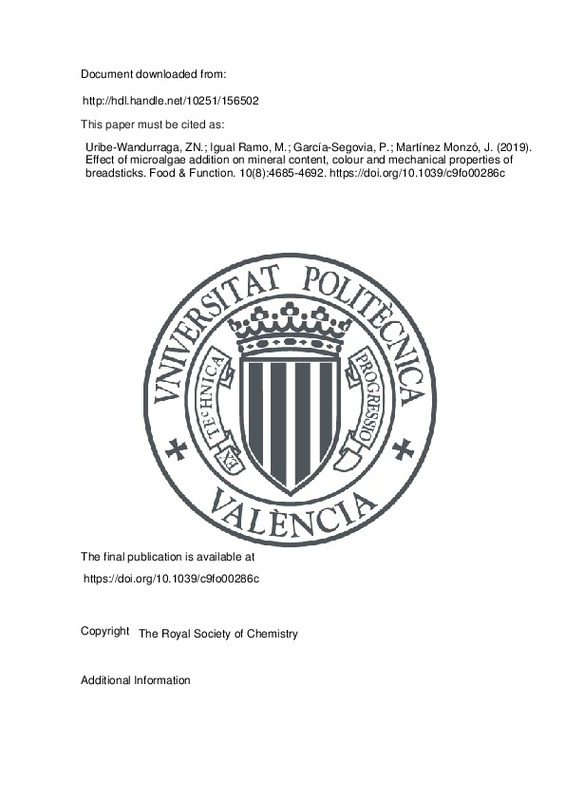Volk, R.-B. (2008). A newly developed assay for the quantitative determination of antimicrobial (anticyanobacterial) activity of both hydrophilic and lipophilic test compounds without any restriction. Microbiological Research, 163(2), 161-167. doi:10.1016/j.micres.2006.03.015
Ibañez, E., & Cifuentes, A. (2013). Benefits of using algae as natural sources of functional ingredients. Journal of the Science of Food and Agriculture, 93(4), 703-709. doi:10.1002/jsfa.6023
Borowitzka, M. A. (2013). High-value products from microalgae—their development and commercialisation. Journal of Applied Phycology, 25(3), 743-756. doi:10.1007/s10811-013-9983-9
[+]
Volk, R.-B. (2008). A newly developed assay for the quantitative determination of antimicrobial (anticyanobacterial) activity of both hydrophilic and lipophilic test compounds without any restriction. Microbiological Research, 163(2), 161-167. doi:10.1016/j.micres.2006.03.015
Ibañez, E., & Cifuentes, A. (2013). Benefits of using algae as natural sources of functional ingredients. Journal of the Science of Food and Agriculture, 93(4), 703-709. doi:10.1002/jsfa.6023
Borowitzka, M. A. (2013). High-value products from microalgae—their development and commercialisation. Journal of Applied Phycology, 25(3), 743-756. doi:10.1007/s10811-013-9983-9
J. A. C. Costa and M. G.Morais , in Fermentation Process Engineering in the Food Industry , ed. C. R. Soccoll , A. Pandey and C. Larroche , CRC press, Taylor & Francis Group , Boca Raton, FL , 2013 , ch. 16, pp. 405–428
Soni, R. A., Sudhakar, K., & Rana, R. S. (2017). Spirulina – From growth to nutritional product: A review. Trends in Food Science & Technology, 69, 157-171. doi:10.1016/j.tifs.2017.09.010
Batista, A. P., Gouveia, L., Bandarra, N. M., Franco, J. M., & Raymundo, A. (2013). Comparison of microalgal biomass profiles as novel functional ingredient for food products. Algal Research, 2(2), 164-173. doi:10.1016/j.algal.2013.01.004
Batista, A. P., Nunes, M. C., Fradinho, P., Gouveia, L., Sousa, I., Raymundo, A., & Franco, J. M. (2012). Novel foods with microalgal ingredients – Effect of gel setting conditions on the linear viscoelasticity of Spirulina and Haematococcus gels. Journal of Food Engineering, 110(2), 182-189. doi:10.1016/j.jfoodeng.2011.05.044
Chacón-Lee, T. L., & González-Mariño, G. E. (2010). Microalgae for «Healthy» Foods-Possibilities and Challenges. Comprehensive Reviews in Food Science and Food Safety, 9(6), 655-675. doi:10.1111/j.1541-4337.2010.00132.x
Kadam, S. U., & Prabhasankar, P. (2010). Marine foods as functional ingredients in bakery and pasta products. Food Research International, 43(8), 1975-1980. doi:10.1016/j.foodres.2010.06.007
Roohinejad, S., Koubaa, M., Barba, F. J., Saljoughian, S., Amid, M., & Greiner, R. (2017). Application of seaweeds to develop new food products with enhanced shelf-life, quality and health-related beneficial properties. Food Research International, 99, 1066-1083. doi:10.1016/j.foodres.2016.08.016
Potter, R., Stojceska, V., & Plunkett, A. (2013). The use of fruit powders in extruded snacks suitable for Children’s diets. LWT - Food Science and Technology, 51(2), 537-544. doi:10.1016/j.lwt.2012.11.015
Shahbazizadeh, S., Khosravi-Darani, K., & Sohrabvandi, S. (2015). Fortification of Iranian Traditional Cookies with Spirulina platensis. Annual Research & Review in Biology, 7(3), 144-154. doi:10.9734/arrb/2015/13492
W. Horwitz and G. W.Latimer , Official methods of analysis of AOAC International , 2005
Fernández-Ruiz, V., Olives, A. I., Cámara, M., Sánchez-Mata, M. de C., & Torija, M. E. (2010). Mineral and Trace Elements Content in 30 Accessions of Tomato Fruits (Solanum lycopersicum L.,) and Wild Relatives (Solanum pimpinellifolium L., Solanum cheesmaniae L. Riley, and Solanum habrochaites S. Knapp & D.M. Spooner). Biological Trace Element Research, 141(1-3), 329-339. doi:10.1007/s12011-010-8738-6
Devi, A., & Khatkar, B. S. (2016). Physicochemical, rheological and functional properties of fats and oils in relation to cookie quality: a review. Journal of Food Science and Technology, 53(10), 3633-3641. doi:10.1007/s13197-016-2355-0
Inglett, G. E., Chen, D., & Liu, S. X. (2015). Physical properties of gluten-free sugar cookies made from amaranth–oat composites. LWT - Food Science and Technology, 63(1), 214-220. doi:10.1016/j.lwt.2015.03.056
Buono, S., Langellotti, A. L., Martello, A., Rinna, F., & Fogliano, V. (2014). Functional ingredients from microalgae. Food Funct., 5(8), 1669-1685. doi:10.1039/c4fo00125g
Mancebo, C. M., Rodriguez, P., & Gómez, M. (2016). Assessing rice flour-starch-protein mixtures to produce gluten free sugar-snap cookies. LWT - Food Science and Technology, 67, 127-132. doi:10.1016/j.lwt.2015.11.045
Graça, C., Fradinho, P., Sousa, I., & Raymundo, A. (2018). Impact of Chlorella vulgaris on the rheology of wheat flour dough and bread texture. LWT, 89, 466-474. doi:10.1016/j.lwt.2017.11.024
Bodart, M., de Peñaranda, R., Deneyer, A., & Flamant, G. (2008). Photometry and colorimetry characterisation of materials in daylighting evaluation tools. Building and Environment, 43(12), 2046-2058. doi:10.1016/j.buildenv.2007.12.006
Gouveia, L., Batista, A. P., Miranda, A., Empis, J., & Raymundo, A. (2007). Chlorella vulgaris biomass used as colouring source in traditional butter cookies. Innovative Food Science & Emerging Technologies, 8(3), 433-436. doi:10.1016/j.ifset.2007.03.026
Batista, A. P., Niccolai, A., Fradinho, P., Fragoso, S., Bursic, I., Rodolfi, L., … Raymundo, A. (2017). Microalgae biomass as an alternative ingredient in cookies: Sensory, physical and chemical properties, antioxidant activity and in vitro digestibility. Algal Research, 26, 161-171. doi:10.1016/j.algal.2017.07.017
García-Segovia, P., Pagán-Moreno, M. J., Lara, I. F., & Martínez-Monzó, J. (2017). Effect of microalgae incorporation on physicochemical and textural properties in wheat bread formulation. Food Science and Technology International, 23(5), 437-447. doi:10.1177/1082013217700259
M. C. Latham , in Nutrición humana en el mundo en desarrollo , FAO , New York, USA , 2002 , ch. 10
World Health Organization , Iron Deficiency Anemia: Assessment, Prevention, and Control , WHO/UNICEF/UNU , Geneva, Switzerland , 2001
Rayman, M. P. (2000). The importance of selenium to human health. The Lancet, 356(9225), 233-241. doi:10.1016/s0140-6736(00)02490-9
[-]







![[Cerrado]](/themes/UPV/images/candado.png)


